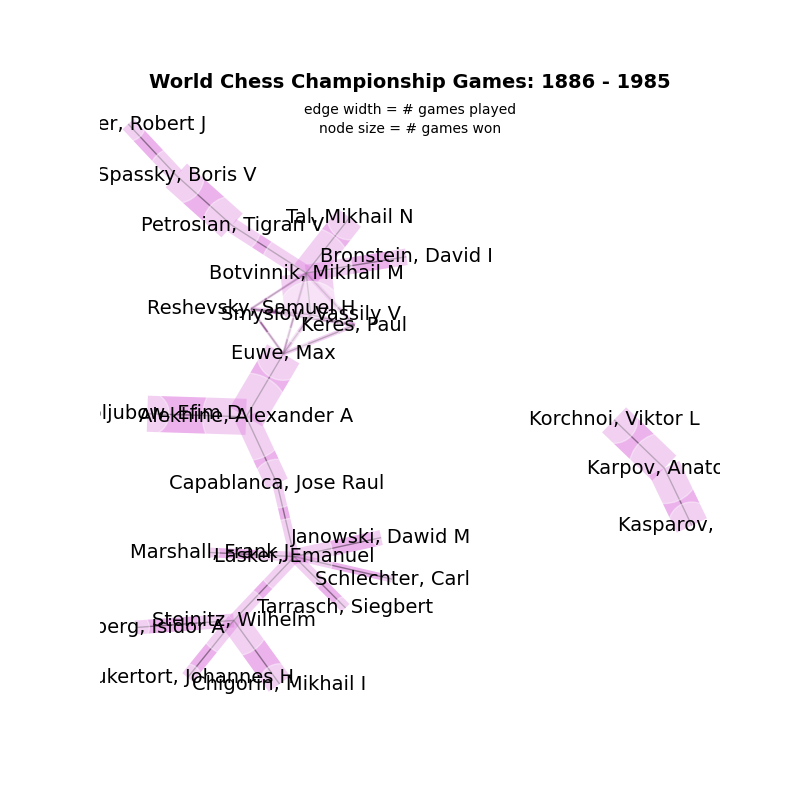Note
Click here to download the full example code
Chess Masters¶
An example of the MultiDiGraph clas
The function chess_pgn_graph reads a collection of chess matches stored in the specified PGN file (PGN =”Portable Game Notation”). Here the (compressed) default file:
chess_masters_WCC.pgn.bz2
contains all 685 World Chess Championship matches from 1886–1985. (data from http://chessproblem.my-free-games.com/chess/games/Download-PGN.php)
The chess_pgn_graph() function returns a MultiDiGraph with multiple edges.
Each node is the last name of a chess master. Each edge is directed from white
to black and contains selected game info.
The key statement in chess_pgn_graph below is:
G.add_edge(white, black, game_info)
where game_info is a dict describing each game.

Out:
Loaded 685 chess games between 25 players
Note the disconnected component consisting of:
['Kasparov, Gary', 'Karpov, Anatoly', 'Korchnoi, Viktor L']
From a total of 237 different openings,
the following games used the Sicilian opening
with the Najdorff 7...Qb6 "Poisoned Pawn" variation.
Spassky, Boris V vs Fischer, Robert J
Event : World Championship 28th
Site : Reykjavik ISL
Date : 1972.07.25
Round : 7
Result : 1/2-1/2
WhiteElo : 2660
BlackElo : 2785
ECO : B97
EventDate : 1972.07.11
Spassky, Boris V vs Fischer, Robert J
Event : World Championship 28th
Site : Reykjavik ISL
Date : 1972.08.06
Round : 11
Result : 1-0
WhiteElo : 2660
BlackElo : 2785
ECO : B97
EventDate : 1972.07.11
import matplotlib.pyplot as plt
import networkx as nx
# tag names specifying what game info should be
# stored in the dict on each digraph edge
game_details = ["Event", "Date", "Result", "ECO", "Site"]
def chess_pgn_graph(pgn_file="chess_masters_WCC.pgn.bz2"):
"""Read chess games in pgn format in pgn_file.
Filenames ending in .gz or .bz2 will be uncompressed.
Return the MultiDiGraph of players connected by a chess game.
Edges contain game data in a dict.
"""
import bz2
G = nx.MultiDiGraph()
game = {}
datafile = bz2.BZ2File(pgn_file)
lines = (line.decode().rstrip("\r\n") for line in datafile)
for line in lines:
if line.startswith("["):
tag, value = line[1:-1].split(" ", 1)
game[str(tag)] = value.strip('"')
else:
# empty line after tag set indicates
# we finished reading game info
if game:
white = game.pop("White")
black = game.pop("Black")
G.add_edge(white, black, **game)
game = {}
return G
G = chess_pgn_graph()
ngames = G.number_of_edges()
nplayers = G.number_of_nodes()
print(f"Loaded {ngames} chess games between {nplayers} players\n")
# identify connected components
# of the undirected version
H = G.to_undirected()
Gcc = [H.subgraph(c) for c in nx.connected_components(H)]
if len(Gcc) > 1:
print("Note the disconnected component consisting of:")
print(Gcc[1].nodes())
# find all games with B97 opening (as described in ECO)
openings = {game_info["ECO"] for (white, black, game_info) in G.edges(data=True)}
print(f"\nFrom a total of {len(openings)} different openings,")
print("the following games used the Sicilian opening")
print('with the Najdorff 7...Qb6 "Poisoned Pawn" variation.\n')
for (white, black, game_info) in G.edges(data=True):
if game_info["ECO"] == "B97":
print(white, "vs", black)
for k, v in game_info.items():
print(" ", k, ": ", v)
print("\n")
# make new undirected graph H without multi-edges
H = nx.Graph(G)
# edge width is proportional number of games played
edgewidth = []
for (u, v, d) in H.edges(data=True):
edgewidth.append(len(G.get_edge_data(u, v)))
# node size is proportional to number of games won
wins = dict.fromkeys(G.nodes(), 0.0)
for (u, v, d) in G.edges(data=True):
r = d["Result"].split("-")
if r[0] == "1":
wins[u] += 1.0
elif r[0] == "1/2":
wins[u] += 0.5
wins[v] += 0.5
else:
wins[v] += 1.0
try:
pos = nx.nx_agraph.graphviz_layout(H)
except ImportError:
pos = nx.spring_layout(H, iterations=20)
plt.rcParams["text.usetex"] = False
plt.figure(figsize=(8, 8))
nx.draw_networkx_edges(H, pos, alpha=0.3, width=edgewidth, edge_color="m")
nodesize = [wins[v] * 50 for v in H]
nx.draw_networkx_nodes(H, pos, node_size=nodesize, node_color="w", alpha=0.4)
nx.draw_networkx_edges(H, pos, alpha=0.4, node_size=0, width=1, edge_color="k")
nx.draw_networkx_labels(H, pos, font_size=14)
font = {"fontname": "Helvetica", "color": "k", "fontweight": "bold", "fontsize": 14}
plt.title("World Chess Championship Games: 1886 - 1985", font)
# change font and write text (using data coordinates)
font = {"fontname": "Helvetica", "color": "r", "fontweight": "bold", "fontsize": 14}
plt.text(
0.5,
0.97,
"edge width = # games played",
horizontalalignment="center",
transform=plt.gca().transAxes,
)
plt.text(
0.5,
0.94,
"node size = # games won",
horizontalalignment="center",
transform=plt.gca().transAxes,
)
plt.axis("off")
plt.show()
Total running time of the script: ( 0 minutes 0.342 seconds)